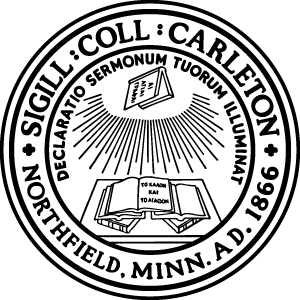
The Latin surrounding the Carleton Seal is fairly straightforward, and there are probably enough students out there who can translate it to make it an easy bet for a late-night trivia kind of a question.
The outer ring carries the abbreviations SIGILL : COLL : CARLETON. The full words would be sigillum collegii, or “Seal of the College.” The inner ring has DECLARATIO SERMONUM TUORUM ILLUMINAT, or “The Revelation/Announcement of Your Words Illuminates.”
But who is the “you” of “your words?” And what, exactly, is being illuminated there in the image?
Due to the eroding process that takes place when copies are made from copies over many years, reproductions of the Carleton Seal (such as those on Carleton folders or pens) often appear to have simple hen scratches on the books pictured at the center. But in good reproductions, it is possible to see that in fact the books are inscribed with Greek characters.
The upper, central book carries the legend: AI AGIAI GRAFAI, or “hai hagiai graphai.” This means “the sacred writings” and refers to the Scriptures of the Christian tradition. The books at the bottom of the picture, receiving rays of illumination from the top one, are marked TO KALON KAI TO AGATHON, or “to kalon kai to agathon.” This means literally “the good and noble.” It was always the expression used in ancient Greek to refer to the most highly prized qualities of the heroic aristocratic tradition. Here, it signifies the texts of the Classical tradition.
What the seal shows, then, is the illumination of those dangerous yet attractive pagan texts in the holy rays of Christian Scripture. What do you think of that?